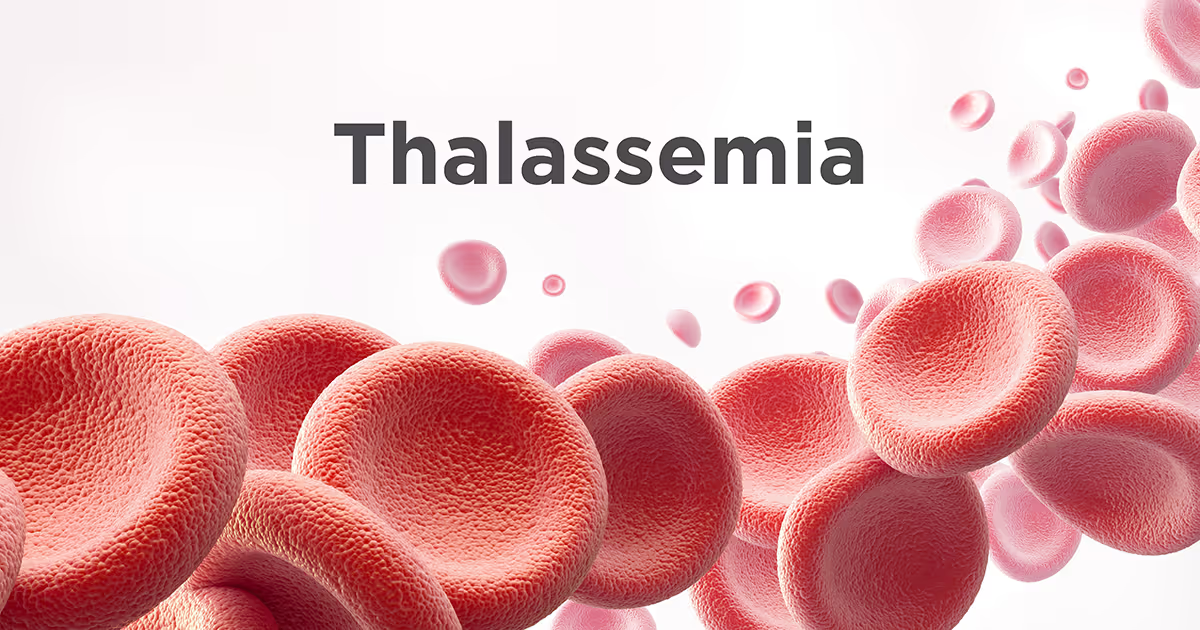Choose the content to read
- What is Thalassemia?
- What causes thalassemia?
- How many types of thalassemia?
- What are the symptoms of thalassemia?
- How is thalassemia diagnosed?
- What are the treatments for thalassemia?
- Healthy living with thalassemia
- Frequently Asked Questions
Thalassemia
Thalassemia is a hereditary blood disorder characterized by defective hemoglobin synthesis due to genetic disorders resulting in abnormalities of red blood cells. It can lead to reduced production of normal hemoglobin, shortened lifespan of red blood cells, and a deficiency in the oxygen-carrying capacity of the red blood cells. This genetic condition causes chronic anemia, fatigue, pallor, and other complications. Treatments for severe cases require blood transfusions. It is curable with bone marrow or stem cell transplantation.
What causes thalassemia?
Thalassemia is due to inherited mutated genes of the subunits of a hemoglobin molecule. A hemoglobin molecule has two pairs of two globin chains called alpha-globin and beta-globin. Defects or the absence of these genes are the direct cause of thalassemia. Therefore, the severity of the disorder depends on the number of missing and/or mutated genes.
How many types of thalassemia?
There are two types of thalassemia: alpha-thalassemia and beta-thalassemia. Symptom severity varies depending on the characteristics of gene defects inherited from parents, ranging from asymptomatic, mild, and moderate to severe, necessitating periodic blood transfusions.
- Alpha thalassemia: There are two copies of the alpha-globin gene on chromosome 16. People usually have four alpha-globin gene copies, two from each parent. The severity of alpha-thalassemia depends on the number of missing genes inherited. The higher the loss of alpha-globin genes, the more severe the disease. Alpha thalassemia is a leading cause of fetal, maternal, and postnatal mortality. A surviving infant typically requires lifelong blood transfusions.
- Beta thalassemia: People have two copies of beta-globin genes, one on each pair of chromosomes 11. Individuals with beta-thalassemia inherit defective beta-globin genes from their parents. The number and type of defective genes or mutations in the beta-globin gene determines symptom severity. A single copy of the normal beta-globin gene is usually asymptomatic with mild or moderate anemia. Severe beta-thalassemia with two missing or one missing and one defective beta-globin gene may manifest as thalassemia major or Cooley's anemia by age 1 to 2 years, with symptoms related to severe anemia.
How many ways can thalassemia be transmitted?
Both thalassemia carriers and patients can transmit their defective genes to their descendants.
What are the symptoms of thalassemia?
Although individuals with the same type of thalassemia share a common diagnosis, the specific symptoms may vary depending on the severity of the inherited gene abnormalities.
- Symptomatic thalassemia carriers with mild anemia may exhibit easy fatiguability, weakness, or no symptoms.
- Those with mild to moderate symptoms may require occasional blood transfusions and may exhibit any of the following symptoms:
- Fatigue, tiredness
- Slight anemia.
- Slow growth
- Overworked heart
- Delayed puberty
- Bone disorders such as osteoporosis
- Enlarged spleen.
- Individuals with severe symptoms with the diagnosis of thalassemia major or Cooley’s anemia often require regular blood transfusions and often exhibit the following symptoms:
- Poor appetite
- Markedly pale skin due to hemolytic crisis
- Yellowish skin and eyes or jaundice
- Dark or tea-colored urine
- Markedly enlarged spleen.
- Brittle bones prone to fracture
- Difficulty breathing
- Abnormal facial bone structure, a thick skull, high cheekbones, and a high forehead due to the expansion of the bone marrow.
- Fetal death or postnatal death with severe anemia, edema, and heart failure
How is thalassemia diagnosed?
The thalassemia diagnosis derives from various means, including an initial history, physical examination, and specific tests. Here is a summary of the diagnostic steps for thalassemia:
- A complete blood count (CBC): The CBC measures the hemoglobin level and numbers of different blood cells, including red blood cells, white blood cells, and platelets. In thalassemia, there is often a decrease in the size and number of red blood cells and lower hemoglobin levels.
- Hemoglobin typing (Hb typing): This test analyzes the type and quantity of hemoglobin in the red blood cells. It helps identify thalassemia carriers and distinguish the specific type of thalassemia.
- DNA testing: Usually done in prenatal diagnosis by examining the genetic material, DNA testing can detect mutated genes, defects in all 23 chromosome pairs, or missing chromosomes, including for thalassemia genes.
- Non-invasive prenatal testing (NIPT): This screening test is performed on maternal blood to examine fragments of circulating fetal DNA during pregnancy to assess the risk of fetal chromosomal abnormalities, including thalassemia and Down syndrome. It can provide information within 5 - 14 days without harming the fetus.

What are the treatments for thalassemia?
The treatment for thalassemia depends on the type and severity of the conditions. A thalassemia carrier can live a regular life without the need for medication. Individuals with severe thalassemia or chronic anemia should be under the care of a specialist doctor, receiving systematic treatment, periodically having a blood test, and monitoring their symptoms throughout their lives. Thalassemia treatment options include the following:
- Blood transfusion: Individuals with moderate to severe thalassemia may need regular blood transfusions to restore healthy red blood cells and hemoglobin levels (high transfusion). Young children may require blood transfusions every 1-2 months to promote normal growth and development, preventing excessive iron absorption in the gastrointestinal tract and facial bone deformity, including those with severe fatigue or anemia after an infectious fever (low transfusion).
- Iron chelation: Regular blood transfusions can lead to iron overload, harming organs. Iron chelation therapy involves using medications to remove excess iron and prevent organ damage.
- Folic acid supplements: Folic acid helps stimulate the production of new, healthy cells, including red blood cells.
- Splenectomy: In severe cases, surgical removal of the spleen (splenectomy) may be beneficial if the spleen is enlarged or causes complications such as severe anemia or low blood cell counts. The doctor will administer an infection-prevention vaccine at least two weeks before the surgery.
- Bone marrow transplants and stem cell transplantation: These procedures are currently the only known curative treatments for thalassemia, particularly in young children. They involve replacing defective bone marrow stem cells with healthy umbilical cord blood stem cells to promote the production of normal blood cells.
What are the complications of thalassemia?
Complications of thalassemia primarily arise from anemia, rapid breakdown of red blood cells, big spleen, overactive bone marrow, and iron overload from blood transfusions. Excess iron can lead to complications such as heart failure, cirrhosis, pancreatic damage, diabetes, slower blood clotting, endocrine system disorders, or septicemia. Doctors will order regular blood tests to monitor iron levels and prevent potential side effects.
Healthy living with thalassemia
Thalassemia carriers with mild thalassemia symptoms typically do not require medical treatment. However, those planning to have children should seek genetic counseling and prenatal care to assess the risks and take appropriate measures to prevent thalassemia transmission to future generations. Healthy lifestyle in managing the disorder and making healthy choices include:
- Eating nutritious foods.
- Premarital checkup
- Prenatal care program, a preconception checkup
- Annual health check
- Do not purchase a blood tonic to consume on your own.
- Exercise regularly
- Maintain an up-to-date vaccination status.
Thalassemia, a treatable inherited blood disorder
Those who have thalassemia can pass on abnormal genes to their children. Premarital health checkups and prenatal cares are essential to thalassemia carriers or parents and those with a family history of thalassemia to prevent transmission of the faulty genes to their offspring.
With cutting-edge medical innovations and advancements in medical technology, we now have curative treatment with bone marrow and stem cell transplantation and effective treatments for thalassemia complications. A multidisciplinary team of specialists, including hematologists, provides holistic care to individuals with thalassemia, enabling them to manage the condition leading to healthier lives.
FAQ
- What is thalassemia?
Thalassemia is an inherited blood disorder characterized by the inability to produce normal hemoglobin (anemia), which is essential for producing healthy red blood cells, leading to the decreased production of normal hemoglobin and a shortened lifespan of red blood cells. - Which doctor treats thalassemia?
If you have thalassemia, a hematologist can perform proper diagnosis and treatment for you. - When should a child get a screening test for thalassemia?
A Complete Blood Count (CBC) and Hb Electrophoresis can be conducted to diagnose thalassemia when the child is around 12 months old or earlier if the child experiences severe anemia before the age of 6 months. DNA analysis can also be used to detect thalassemia at any age. Carrier screening in parents is necessary for the diagnosis of the disease. - Who is a thalassemia carrier?
A thalassemia carrier, specifically beta thalassemia carrier, does not display any symptoms and may be unaware of their carrier status until they undergo testing. Carriers inherit one normal gene from one parent and one defective gene from the other parent. They are referred to as having the thalassemia trait or being carriers. Being a carrier does not constitute a diseased state and does not require any treatment.






